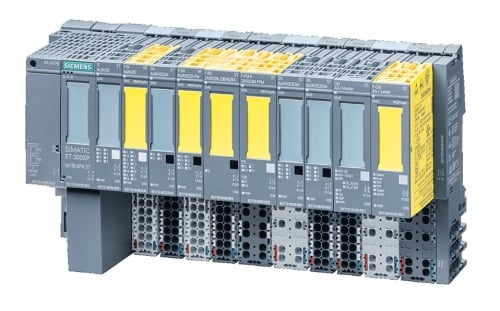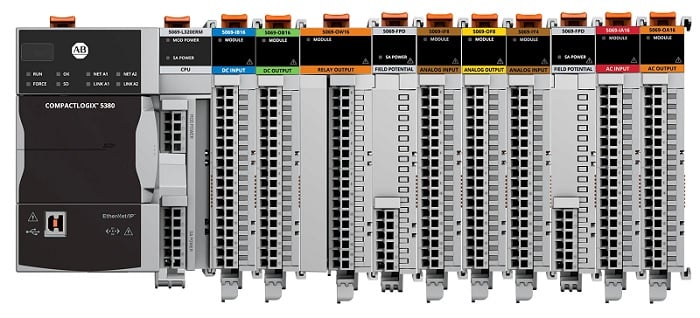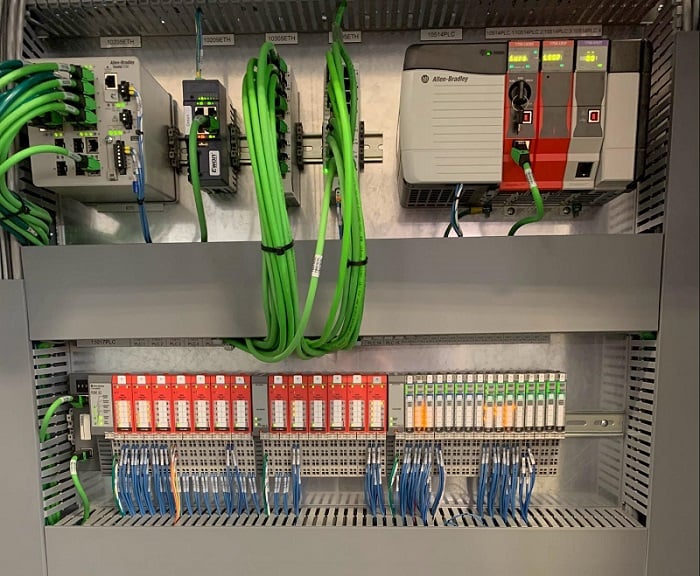Embedded, modular, panel mount, distributed, machine mount, and remote, oh my! What does it all mean, and how are you supposed to know which one to choose for your application?
The automation industry has changed quite a lot over the last two decades. In the ‘good old days’ of automation, if you wanted to add inputs and outputs to your automation equipment, you had to add cards into your PLC racks and run wires out to the field devices.
These racks of expansion cards were large, expensive, they took up real estate in the control cabinet, and you could only add as many as you had spare slots in the rack.
Today, we have many choices regarding wiring inputs and outputs to a PLC. What different kinds of I/O exist? Furthermore, when should you use remote I/O and when is it better to use embedded I/O?

Figure 1. Collection of I/O blocks.
Embedded I/O
Some of the small, compact PLCs come with a limited number of inputs and outputs built into the controller. These are called embedded I/O and often have a wide variety of different kinds. The Micro 800 series PLC from Allen-Bradley comes with digital input and output, analog input and output, and some have PWM outputs. Siemens and Omron also have smaller PLCs with embedded I/O. The embedded I/O is addressed directly in the ladder logic and is often quite fast as the input or output terminals are soldered directly on the control board.

Figure 2. Small PLC with embedded I/O.
Remote I/O
The remote style of I/O is often found in the field next to actuators or processes, and as such, often goes by the title of ‘machine mounted’ I/O. Typically, these I/O blocks can withstand washdown or dusty environments. Connecting inputs and outputs to these devices often require a standard M8 or M12 connector.
A standard remote I/O block will often use industrial fieldbus protocols, such as PROFINET, Ethernet/IP, or EtherCAT to communicate with the control system. Each manufacturer has different sizes of I/O blocks but they more often come in 8 or 16 configurable digital input and digital output versions. Analog I/O is often not supported but there are options to make it work (like the IO-Link protocol). Safety I/O blocks are available on the market, but typically one block cannot do both safety and standard I/O.
The number of I/O ports cannot be expanded, if you need more inputs or outputs after integration, another block must be purchased.

Figure 3. Remote I/O blocks with different densities and configurations. Image used courtesy of the Control.com engineering team
Panel Mount I/O
Sometimes referred to as distributed I/O, and similar to remote I/O, panel I/O can be found in the field but it must be installed within an electrical cabinet as it is not IP rated or they can be found in the same control cabinet as the PLC. The number and type of inputs and outputs can be configured by adding or removing cards from the panel I/O rack. A single rack can contain both standard and safety I/O, as well as both digital and analog I/O simultaneously.
Both Siemens and Allen-Bradley have a wide selection of I/O cards for their Panel I/O systems. Industrial Ethernet protocols are used to communicate with the PLC, so there might be some latency in the reaction time of the system. Each input or output must be individually wired using the provided terminals which can be time-consuming and prone to wiring errors. The size of the rack and the type of I/O cards need to be configured in the PLC program so that the correct amount of data can be sent to the panel I/O communication slice.

Figure 4. Siemens ET200 distributed I/O rack with safety and non-safety cards.
Expansion Cards (Modules)
Most PLCs today can add expansion cards directly to the PLC, which expands the number and type of I/O connected directly to the PLC backplane. Both the Micro800 series and the S7-1200 series from Allen-Bradley and Siemens feature embedded I/O terminals, but also offer expansion cards for digital I/O, serial communication, analog I/O, and combination I/O cards.
The larger models, such as the CompactLogix and S7-1500 series, have an even wider selection of expansion cards that can be added. Expansion cards react faster because they are not subjected to communication latencies found with panel and remote I/O systems.
Expansion cards often have a higher density of inputs and outputs per card. Similar to the panel I/O each input or output will need to be wired directly to the terminal and both standard and safety I/O can be installed on the same backplane.

Figure 5. CompactLogix PLC with expansion cards installed.
So Many Choices for I/O Connections
With so many different types of I/O and manufacturers, how does one choose which one to buy for their project? Like most decisions in machine design, you need to look at your application and your budget.
Some machine builders will standardize on using panel I/O and install the I/O rack in the same cabinet as the PLC. This saves design time if the PLC changes from a ControlLogix to a CompactLogix between projects. There is a cost-savings as well, since the ControlLogix digital input card is roughly eight times the price of a panel digital input card.

Figure 7. Picture of an active project showing a PLC and panel I/O in one cabinet. Image used courtesy of the author
If you need to put I/O on a robot gripper, you are likely to use a remote I/O block. This results in fewer cables and gives you a more robust system that won’t be prone to breakdown due to environmental conditions. The speed of the I/O can be another issue, if you need to monitor an input in motion or fire an output at a specific time, you will likely need to use an embedded or expansion card and hard wire the sensor or actuator. High-speed input cards can be purchased for panel I/O and remote I/O, but your network speed will need to accommodate those specialty cards.
What I have mostly seen in the industry is the use of panel I/O for all the safety and hard-wired inputs and outputs such as contactors and STO signals, then remote I/O for field sensors like robot grippers and conveyor sensors. This way, the amount of wires going in and out of the control cabinet is reduced. Some of the smaller PLCs won’t connect to remote I/O so you will need to use embedded or expansion modules. Ultimately, you need to evaluate your application and determine which option is the most economical.
Copyright Statement: The content of this website is intended for personal learning purposes only. If it infringes upon your copyright, please contact us for removal. Email: admin@eleok.com
